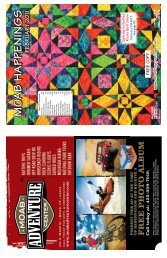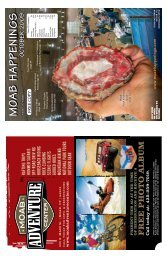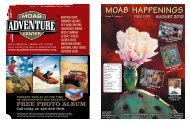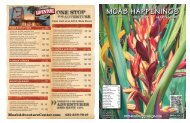December 2011 - Moab Happenings
December 2011 - Moab Happenings
December 2011 - Moab Happenings
Create successful ePaper yourself
Turn your PDF publications into a flip-book with our unique Google optimized e-Paper software.
6A • <strong>December</strong> <strong>2011</strong> • <strong>Moab</strong> <strong>Happenings</strong><br />
www.moabhappenings.com<br />
WINTER RECREATION HAPPENINGS<br />
Winter in the La Sal Mountains<br />
When the weather in <strong>Moab</strong> gets cold, freezing the Colorado<br />
River and putting snow and ice on everybody’s favorite bike<br />
trail or climbing route, there is another alternative available.<br />
Find yourself in an inversion? It is time to go and discover the<br />
recreation opportunities in the La Sal Mountains.<br />
The La Sals are second only to the Uintas as the highest<br />
peaks in the state of Utah. These mountains soar to almost<br />
13,000 feet above sea level and over 8,000 feet above the<br />
valley floor. A laccolith process formed the La Sals. With<br />
this process, a mass of igneous rock intruded between layers<br />
of sedimentary rock, resulting in uplift. You could call them<br />
frustrated volcanoes too. Aside from the volcanoes of the<br />
Pacific-Northwest, there are no peaks with greater rise in the<br />
continental U.S.<br />
Winter recreation in the La Sals includes cross country<br />
skiing, skate skiing, snowshoeing, sledding, back-country<br />
skiing and snowmobiling. The winter access to the<br />
mountains is provided from two routes kept open by the<br />
Grand and San Juan County Road Departments.<br />
Avalanche Hazard<br />
in the La Sal Mountains<br />
The La Sals are rubbly piles of fractured stone. The<br />
angle of repose for this broken stone is 38 degrees, and since<br />
snow is also a granular substance, 38 degrees is the bulls-eye<br />
slope angle for snow avalanches. Keep in mind though, that<br />
avalanches run on terrain from 30 - 45 degrees.<br />
Most people caught in avalanches are in terrain<br />
that is 30 - 35 degrees of steepness. The La Sal<br />
Mountains usually possess one of the weakest<br />
snow packs imaginable.<br />
Why do we care? Because 30% of people<br />
completely buried by avalanches are killed by<br />
trauma and many of those remaining die from<br />
FOR CURRENT ADVISORIES<br />
259-SNOW (7669)<br />
or on the Internet at<br />
http://utahavalanchecenter/advisory/moab<br />
1. The La Sal Mountain Loop Road is plowed regularly.<br />
The Geyser Pass road is kept open to the restrooms and parking<br />
area at 9,600’. The Geyser Pass Road and Gold Basin Road<br />
beyond the winter trailhead is a popular area for cross country<br />
skiing, snowshoeing and snowmobiling. Groomed trails<br />
are provided by the Lower Utah Nordic Alliance (LUNA).<br />
Volunteers groom trails approximately twice a week, which<br />
provide 12 kilometers of a groomed trail-system, open to<br />
every winter user group. These roads also provide access to<br />
backcountry skiing and snowboarding in the Mt. Tomasaki<br />
and Gold Basin areas. There is a sledding hill just below the<br />
parking lot. If you are using the sledding hill, please park in<br />
the parking lot so other vehicles can get to the parking lot. The<br />
road in the winter is narrow enough!<br />
Snowmobiles are not allowed to leave the road in Gold<br />
Basin. Please respect this closure of the most popular skiing<br />
area in the La Sals - the rest of the entire range is open to you!<br />
2. From near Old La Sal at the south end of the<br />
range, the road is plowed regularly two miles short of Dark<br />
Canyon Lake, just below Mount Peale. The San Juan<br />
Road Department makes a parking lot at about 9,600’.<br />
Winter Huts are available for rent from…<br />
Tag-A-Long Tours: 435-259-8946<br />
These simple cabins are great for folks who want to<br />
spend several days in the mountains, but don’t want to lose a<br />
couple of hours driving back and forth from town every day.<br />
The hut operators can snow cat your supplies and camping gear<br />
in for you saving you the heavy carry.<br />
Change of the Seasons<br />
The seasons are now teetering between fall and winter<br />
and the roar of tourist season has vanished. <strong>December</strong> brings<br />
tranquility to Dead Horse Point that seemed unimaginable<br />
just a short time ago. The hiking trails remain open of fering<br />
hikers the chance to soak in astonishing views. These are<br />
the views that have inspired countless artists and left lasting<br />
impressions on visitors worldwide. Winter visitors to the<br />
Winter view from Dead Horse State Park<br />
suffocation. These are not good odds.<br />
It’s not good policy to plan on outrunning<br />
an avalanche, even on a fast snowmobile,<br />
because avalanches have been clocked<br />
at well over 200 mph. Grim statistics<br />
showing that snowmobilers are the most<br />
likely people to be killed in avalanches<br />
also support this.<br />
So what do we do? Fortunately, staying safe doesn’t have<br />
to mean staying at home! The good news is that most people<br />
trigger the slide that catches them, so if we learn a little about<br />
snow and adjust our behavior to suit the conditions, we can<br />
continue to enjoy our winter playground!<br />
The Manti-La Sal Avalanche Center in <strong>Moab</strong> exists to<br />
help you make the right decisions. The MLSAC Forecasters<br />
examine the snow and produce an advisory informing you of<br />
where you are most likely to run into problems and just how<br />
sensitive the snow is. They also produce a mountain weather<br />
forecast, work with the <strong>Moab</strong> Winter Search and Rescue<br />
Team and provide avalanche education to the community in<br />
numerous ways. The MLSAC educates the community through<br />
the advisories, classes held periodically, radio announcements<br />
on the weekends on KZMU, the website and at the Geyser<br />
Pass Trailhead information board. The center director is Max<br />
Forgensi.<br />
The website is a great tool for:<br />
• Finding a weather forecast for the <strong>Moab</strong> area,<br />
including radar images<br />
• A current photo gallery of the La Sal Mountains<br />
• Advisories for the La Sals and the Abajo Mountains<br />
• A current course schedule for southeast Utah<br />
Watch for periodic special events like ski swaps and<br />
avalanche awareness classes. If you need to talk to one of the<br />
avalanche forecasters, please call 259-7155 Monday-Friday<br />
during normal business hours and be sure to mention you read<br />
about it in <strong>Moab</strong> <strong>Happenings</strong>.<br />
park gain the pleasure of hiking trails where the footprints<br />
of others have almost entirely faded, leaving an unspoiled<br />
landscape. The Intrepid T rail System remains open until<br />
the f rst big snowfall for those mountain bikers that refuse<br />
to let the changing seasons k eep their tires out of the dirt.<br />
For cold weather campers, the campground of fers heated<br />
running water restrooms all winter long.<br />
The 2 nd annual Christmas Bird Count will kick of f<br />
winter in the park on <strong>December</strong> 21 st . Last year’ s event<br />
turned out a great list of birds. With luck this year we can<br />
expand that list and e ven add a fe w rarely seen species.<br />
Participants will scour the park, making use of all passable<br />
trails in hopes of catching a glimpse of a Chukar, Northern<br />
Goshawk, Pinyon Jay or a number of other birds that make<br />
their home in the Dead Horse Point area. Interested birders<br />
should contact the park for more information.<br />
The photographs of T om Till continue to adorn the<br />
walls of the Bighorn Art Gallery . To view the e xhibit,<br />
“Breathtaking - the Vistas of Dead Horse Point”, be sure<br />
to arrive at the visitor center between 9 a.m. and 5 p.m. as<br />
winter hours are now in effect. The photographic works of<br />
Tom Till call attention to the visual po wer of the canyons<br />
AVALANCHE CLASS SCHEDULES<br />
You can find class announcements online at<br />
•h ttp://utahavalanchecenter.org<br />
•h ttp://www.cnha.org/friends/<br />
or by calling<br />
259-SNOW (7669)<br />
By Jordan Perez<br />
surrounding Dead Horse Point.<br />
Dead Horse Point State Park is located nine miles north<br />
of <strong>Moab</strong> on US 191, and 23 miles south on SR 313. The<br />
visitor center is open daily from 9 a.m. to 5 p.m. through<br />
the winter. The park is open on Christmas Day and Ne w<br />
Year’s Day but the visitor center is closed. Park admission<br />
is $10 per vehicle. For more information, contact the park<br />
at 435-259-2614.








